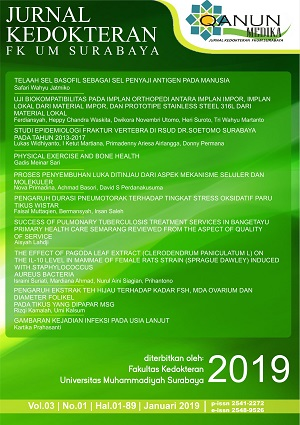Physical Exercise and Bone Health
Abstract
ABSTRACT
Exercise was a planned and structured physical activity in which there was a movement repetition to maintain or enhance one or more components of physical fitness. The physical exercise on biological functions gave positive effects such as improving, but in certain circumstances, it could also give a negative effect such as inhibiting or disturbing the level of individual, system, cell, and molecular. Likewise the effect of physical exercise on bones, many factors affected bone both positively and negatively, among others; the dose of physical exercise which included frequency, intensity, type and time. The dosage of physical exercise was individual on each person. Some studies found that moderate intensity physical exercise provided positive benefits on bones. One of them was affecting the process of proliferation and differentiation of osteoblast, which was one of bone cells that had a function to form bone matrix. Moderate intensity physical exercise combined with salmon calcitonin would increase mouse bone density. Moderate-speed walking exercise would cause changes in IL-6 serum levels which had a role in the process of stem cell differentiation into osteoprogenitor and directly affected adult osteoblasts, whereas changes in PTH serum levels in the sub-acute phase of exercise played a role in the positive uncoupling process of bone remodeling directly.
Keywords                  : moderate intensity physical exercise, bone health
Correspondence to     : gadis-m-s@fk.unair.ac.id
Â
ABSTRAK
Olahraga adalah latihan fisik yang merupakan bagian dari aktivitas fisik yang terencana, terstruktur, terdapat repetisi gerakan, dan mempunyai tujuan mempertahankan atau meningkatkan salah satu atau lebih komponen kebugaran fisik. Pengaruh latihan fisik terhadap fungsi biologis dapat memberi pengaruh positif yaitu bersifat memperbaiki, akan tetapi pada keadaan tertentu dapat pula memberikan pengaruh negatif yaitu menghambat atau mengganggu baik pada tingkat individu, sistem, sel maupun molekul. Demikian juga pengaruh latihan fisik terhadap tulang, banyak faktor yang mempengaruhi tulang secara positif maupun negatif, antara lain adalah dosis latihan fisik yang meliputi frekuensi, intensitas, jenis dan waktu melakukan latihan fisik. Dosis latihan fisik bersifat individual pada setiap orang. Beberapa penelitian menunjukkan bahwa latihan fisik intensitas sedang memberikan manfaat positif pada tulang. Antara lain mempengaruhi proses proliferasi dan diferensiasi sel osteoblas yaitu salah satu sel tulang yang berfungsi membentuk matriks tulang. Latihan fisik intensitas sedang dikombinasikan dengan salmon kalsitonin akan meningkatkan kepadatan tulang tikus. Latihan jalan dengan kecepatan sedang akan menyebabkan perubahan kadar IL-6 serum yang berperan pada proses diferensiasi stem cell menjadi osteoprogenitor dan secara langsung berpengaruh pada osteoblas dewasa, sedangkan perubahan kadar PTH serum pada fase subakut latihan berperan pada proses positive uncoupling remodeling tulang secara langsung.
Kata kunci                 : latihan fisik intensitas sedang, kesehatan tulang
Korespondensi           : gadis-m-s@fk.unair.ac.id
Full text article
References
Baron R, 2006. Anatomy and Ultrastructure of Bone Histogenesis, Growth and Remodeling. http://www.endotext.org.
Bompa TO, 1994. Theory and methodology of training, the key to athletic performance 3rd ed. Lowa: Hunt Publishing Company, pp 24-26.
Burrows M, A M Nevill, S Bird and D Simpson, 2003. Physiological factors associated with low bone mineral density in female endurance runners. Br. J. Sports Med.37;67-71
Chatzitheodorou D, 2007. A Pilot Study of the Effects of High-Intensity Aerobic Exercise Versus Passive Interventions on Pain, Disability, Psychological Strain, and Serum Cortisol Concentrations in People With Chronic Low Back Pain. Physical Therapy, Vol. 87, No. 3, pp. 304312.
Choi Y, 2007. Osteoimmunology. Springer Science Business Media, LLC, Spring Street, New York, pp. 43-46
Datta HK, Ng WF, Walker JA, Tuck SP, Varanasi SS, 2008. The cell biology of bone metabolism. J. Clin. Pathol: 61 : 577-587
Dvorak J, 2006. Glucocorticosteroids in football: use and misuse. British Journal of Sports Medicine; 40(supplement 1): 148-154.
Fox EL. 1993. The physiological basis exercise and sport 5th ed. USA: MW. Crown Communication, pp 287-289, 430-436, 514.
Galli C, 2008. Targeted Deletion of a Distant Transcriptional Enhancer of the Receptor Activator of Nuclear Factor-κB Ligand Gene Reduces Bone Remodeling and Increases Bone Mass. Endocrinology 149(1): 146-153.
Gleeson M, 2007. Immune Function in Sport and Exercise. J. Appl Physiol, Vol. 103, pp. 693-699.
Guyton AC and Hall JE. 2006. Textbook of Medical Physiology 11th ed. Philadelphia: Elsevier Inc, pp 987-990.Ishikawa, 1997. Principles of Bone Biology 3th ed. Elsevier, 2008.
Kohort WM, 2004. Physical Activity and Bone Health. Medicine and Science in Sport and Exercise : 1985.
Lesmana H, 2013. Latihan Fisik Intensitas Submaksimal dan Kalsitonin Salmon Meningkatkan Kepadatan Tulang Tikus Putih Masa Pertumbuhan. Tesis. Program Studi Magister Ilmu Kesehatan Olahraga, Fakultas Kedokteran Universitas Airlangga, Surabaya.
Lorenzo J, Horowitz M, Choi Y, 2008. Osteoimmunology: Interactions of the Bone and Immune System. Endocrine Reviews, 29(4): 4003-440.
Mahmudati N, 2008. Peran Latihan Fisik terhadap Ekspresi ERα, ERK ½, dan IGF-IR pada Osteoblas dalam mempengaruhi Kepadatan Tulang TRikus Putih Betina (Rattus Norvegicus) Usia Muda. Disertasi. Program Pascasarjana Universitas Airlangga, Surabaya.
Now, U. and Nandeesh, BN 2012. Physiology of Bone Formation, Remodeling, and Metabolism in Fogelman, I., et al (eds), Radionuclide and Hybrid Bone Imaging 2012 ; pp 29-57.
Rantalainen T, 2009. Short-term bone biochemical response to a single bout of high-impact exercise. Journal of Sports Science and Medicine; 8:553-559.
Sari GM, 2010. Pengaruh Glukokortikoid Jangka Panjang terhadap Apoptosis Lining Cells tulang (‘Resting Cells’ of Osteoblasts. Laporan Program Penelitian Unggulan Fakultas Kedokteran Universitas Airlangga, Surabaya.
Sari GM, 2012. Mekanisme Gangguan Remodeling Tulang akibat Latihan Fisisk Intensitas Tinggi melalui Perubahan Kadar Glukokortikoid, Osteoprotegerin, Osteokalsin, C-telipeptide dan Jumlah Osteoblas Apoptotik. Disertasi. Program Studi Doktor Ilmu Kedokteran Fakultas Kedokteran Universitas Airlangga, Surabaya.
Tinduh D, 2012. Pengaruh Latihan Jalan Kecepatan Sedang terhadap Mobilisasi, Diferensiasi dan Maturasi Stem Cell pada PBMC serta Remodeling Tulang Perempuan Pasca Menopause. Disertasi. Program Pascasarjana Universitas Airlangga, Surabaya
Watkins J, 2010. Structure and Function of the Musculoskeletal System Second Edition. Human Kinetics Premier Print Group, United States of America, pp. 76-93.
Wilmore,JH, 2008. Physiology of Sport and Exercise. Human Kinetics, PO Box 5076 Champaign, United States of America.
Authors

Qanun Medika by FK UM Surabaya is liscence under Lisensi Creative Commons Atribusi 4.0 Internasional.

